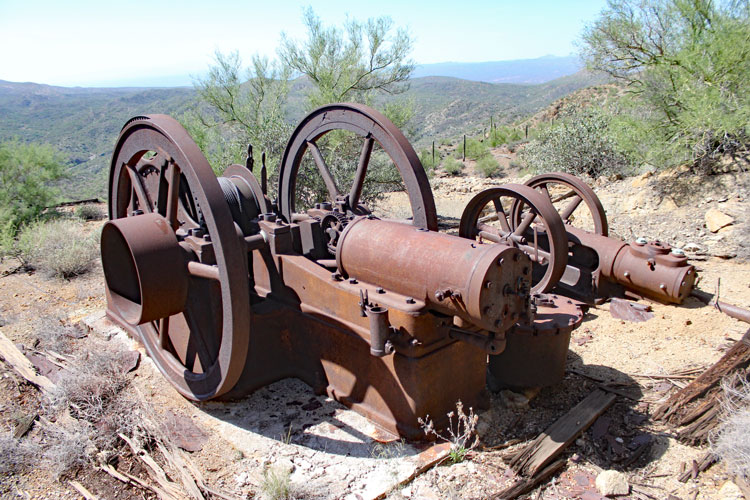 |
The Two Queens Mine fraud of 1908
 |
(This page was originally created in 2018. Early in 2024, I was contacted by the great granddaughter of a woman who had invested in the fraudulent Two Queens Mine operation. She offered to let me have the stock certificates that her great grandmother had received. That donation was the motivation to investigate a bit more the history of the Two Queens Mine operation. What I have learned has been added to the original report in this blue text.)
From all appearances, the Two Queens Mine in eastern Pinal County is a very ordinary site. There are the usual mine dumps, shaft openings, and a few pieces of old mining equipment. What is not evident is the mine's interesting history and its connection to events that occurred 1200 miles away in Kansas City, Missouri.
In 1908, five officials of the Central Mining and Development Company were indicted by a Federal grand jury in Kansas City on the charge of using the U.S. mails to defraud investors who had purchased stock in the Two Queens Mine, a gold and copper prospect, 5 miles northeast of Winkelman.
This newspaper article from the La Clede Blade in Missouri on Novermber 14, 1908 reported on the indictment. The $182,000 that had been collected from the sale of nearly 1.8 million shares of stock would have a value of $4.95 million dollars today. The low price of 10 cents per share apparently attracted thousands of investors.
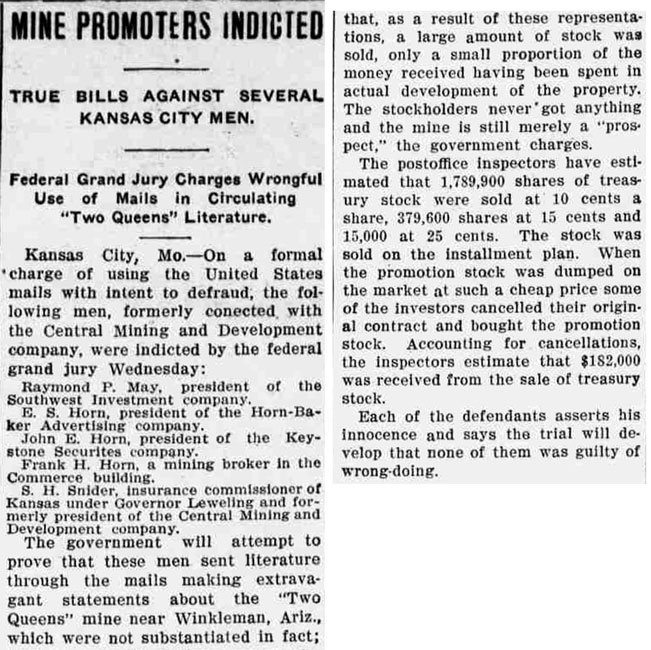 |
These are a few paragraphs from one of the promotional letters. This document had been submitted as evidence in the trial of the promoters. The statements do seem "extravagant".
Dear Sir: I am in the business of helping my clients make money, and the more they make the more I do. You probably read a few weeks ago of the wonderful gold strike made at the Two Queens group of mines in Pinal County, Arizona--gold ore assaying $200,000 to the ton, and in such quantities as to amaze the oldest and most experiened mining men, who all agreed that no richer strike had ever been made in the territory. Probably you also read of the frenzied stampede to secure holdings of Two Queens stock as soon as the news of this magnificent strike became known. The company's offices were simply flooded with orders--letters poured in from all parts of the United States--and the limited allotment of treasury stock set apart for public subscription was swept from the market like a field of ripe grain before the hurricane. The directors of the Central Mining & Development Company at their last meeting authorized the sale of another small block of a limited number of shares of stock, which will be placed on the market January 20th at the price of twenty-five cents per share. This allotment of stock will be swept from the market just as rapidly as the allotment that recently offered at fifteen cents per share. |
In May of 1909, the promoters were found guilty of the charges. Each of the men was fined $500. Frank Horn, E.S. Horn, Raymond May and S.H. Snider were also sentenced to a year and a day at Leavenworth Federal Prison. John Horn, who was only 22, was not given a prision sentence. The men were allowed to remain free on $5,000 bonds while their convictions were appealed. That process did not go well for the promoters. The appellate court found the men guilty once again and the original sentences were upheld. In 1911, the promoters were ordered to report to begin serving their sentences. Only Raymond May and S.H. Snider showed up. Frank Horn and Elisha Horn had fled to Canada.
In a surprising turn of events, S. H. Snider, instead of being locked up, was granted a period of time to make an appeal for leniency to the President of the United States. In his bid for freedom, Snider claimed that he was unaware of the fraudulent activity and had not participated in it. He had actually invested his own money in the mining operation. Snider was able to present letters of support that attested to his good character. The appeal worked. In 1913, President Taft "remitted" his one year prison sentence. Snider would go on to serve as a Justice of the Peace and the Town Treasurer for Winkelman, the town nearby. It is unknown what the ultimate fate was for the other promoters. There are no records that any of the men were ever imprisoned at the Leavenworth prison.
While several of the promoters were at work in Kansas City "mining" investors , there were actual miners on the ground in Arizona. The Two Queens Mine was not a fictional operation. Soon after the organization of the Central Mining and Development Company in 1906, the president, S. H. Snider, moved on to the mine site. S.D. Gardom, the former owner of the Two Queens claims, joined Snider as the mine superintendent. Together, the two men supervised the development of the mine. Several shafts were sunk, and a 400' tunnel was driven into the mountain side. A road was constructed to the mine and a hoist and an air compressor were installed. Newspaper articles from 1907 noted the activity. There were times when both day and night shifts of men were at work. However, despite all of those efforts, only three small shipments of ore ever occurred. The $36 per ton that was brought in was far below the $200,000 value that had been quoted in the promotional literature. The photo below is a Google Earth image of the Two Queens mine site.
Although the Central Mining and Development Company was re-organized and continued in name after the convictions of the promoters, there is no evidence that any more development, or production, ever occurred at the mine site.
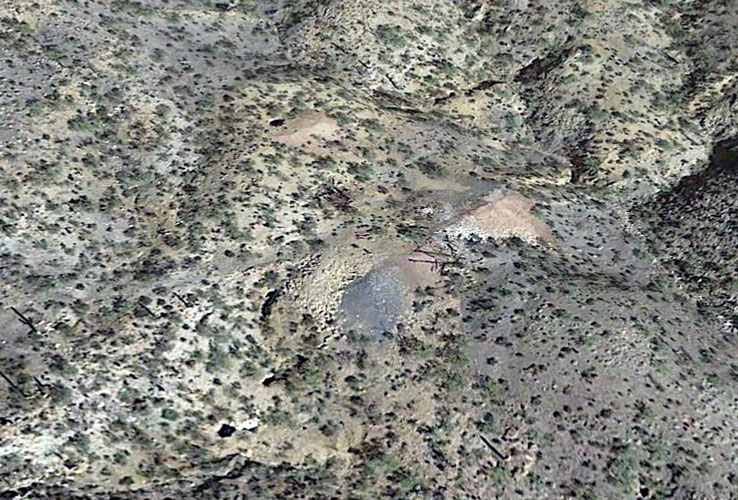 |
A 2024 update on the history of the Two Queens Mine:
This is an example of the stock certificates that were issued to the investors who purchased Central Development and Mining Company stock. The certificates were quite ornate with illustrations of miners swinging their picks located around the border. In the upper left portion of the certificate, the illustration is of a group of miners who are at work underground. The gold seal reads: Central Development and Mining Company Incorporated July 13 1906. The certificate indicated that the company had been registered in Arizona. (Click on the photos for enlarged views)
This certificate acknowledged that 150 shares of stock had been issued to Vesta A. Lefevre on August 31, 1908. Mrs. Lefevre's great granddaughter came across this webpage while researching her great grandmother's investments and graciously offered this certificate and two others to me.
Mrs. Lefevre's great granddaughter reported that Vesta had been a school teacher and lived in Maryland. The certificate represents the third investment that Mrs. Lefevre had made in the Two Queens Mine operation. The other two that I received were from her earlier purchases of the company's stock. Vesta's first purchase, which had occurred in August of 1907, was for 200 shares. Her second acquisition, which occurred a few months later in December of 1907 was for an additional 200 shares. In total, Mrs. Lefevre invested in 550 shares of stock in the fraudulent mine operation. According to Mrs Lefevre's great granddaughter, while her investment in the Two Queens Mine was lost, Vesta did well with her investments in other mines.
I chose the certificate that had been issued in 1908 to display because of its date. This purchase had occurred just a few months before the owners of the mining company were indicted on the fraud charges. Had they known that the indictments were coming when the stocks were sold to Mrs. Lefevre? S. H. Snider whose signature is on the certificate as the President of the company was one of those convicted in the fraud case. His sentence was later commuted by President Taft. Mr. Snider was the only company offical local to the area of the mine.
What intrigued Mrs. Lefevre enough for her to have made three different investments in the Two Queens Mine operation? Was it the price of the stock? As noted in the newspaper article that reported on the mine fraud, nearly one million and seven hundred fifty thousand shares had been sold at the discounted price of 10 cents per share. In 1907, this was an offer that was made. Shares could be purchased at 20 cents each. Payments on an installment plan could be arranged. This offer was only good if the investor acted quickly........
.
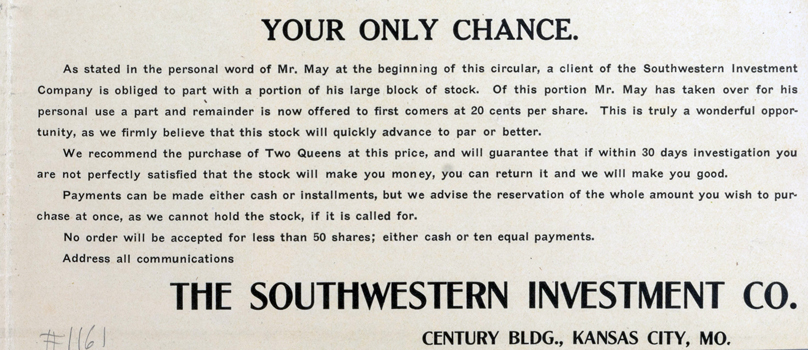 |
Mrs. Lefevre's investment cost would have ranged from $55 in 1907 dollars for the 550 shares if they had been purchased at 10 cents each, to $110 in 1907 dollars if she had purchased them at 20 cents each. Today those costs would be equivalent to approximately $1800 to $3600 . If Mrs. Lefevre had used money from her teacher's salary to purchase the Two Queen's Mine shares, that was not an insignificant amount....
How were the transactions between investors such as Mrs. Lefevre, who was a Maryland resident, and the officials of the Central Mining and Development Company conducted? As noted earlier in this report, communications between company officials and investors were almost always accomplished through the mails. This included the transfer of payments and the stock certificates. Unfortunately, except for the stock certificates, none of the communications with Mrs. Lefevre and the company officials have survived.
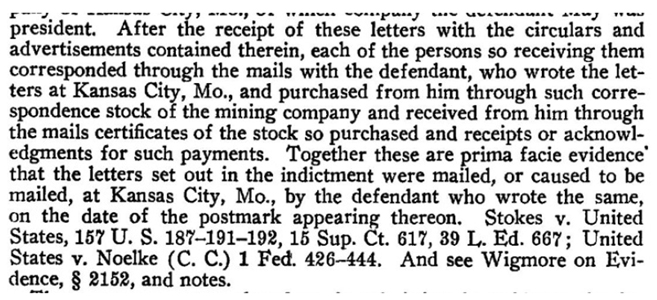 |
What was the nature of the circulars and the advertisements that were included in the correspondence? These are two examples of advertisements that were used by the company in 1907. These documents seemed to present a lot of information about the mining operation. Unfortunately, most of it was an exaggeration or was completely untrue....(Click on the photos for enlarged views)
I found these two illustrations from the documents to be particularly interesting. There has been some "artistic" license taken with the representation of the landmarks that are shown on the map.
 |
 |
How did potential investors become aware of the "opportunity" to invest in the Two Queens Mine operation? Out west, newspapers regularly reported on the mining activity that was occurring in their coverage areas. At Mrs. Lefevre's location in Maryland, I doubt that the Two Mines Operation was ever reported on locally. Since Mrs. Lefevre seems to have been an experienced investor she may have had access to the publication, "The Mining Investor", which advertised itself as the "Weekly Journal for Investors, Operators and Speculators". There were articles published in the journal in March and April of 1907 on the Two Queens Operation.
This is an excerpt from one of those articles. It was signed by Frank Horn, who assured investors that he would take good care of their money. Horn was one of those convicted at the trial. He then fled to Canada to avoid serving his sentence.
 |
The Mine Site today:
The Two Queens Mine is located in scenic desert country approximately 5 miles northeast of Winkelman. The claims are patented, but are not posted against entry. The darker orange color on the BLM map represents San Carlos Indian Reservation lands. Recreation permits, issued by the tribe, are required for travel on the reservation. ATVs are not allowed. The mining claims do extend onto BLM land to the west. Tribal permits are not required to approach the mine from that direction.
Today, travel to the Two Queens Mine that avoids the reservation, involves a ride on a 4x4 road to Ash Creek southwest of the mine. From there it is a one mile walk up the creek bed to the site of the old Two Queens camp. At the old camp site, the road to the Two Queens Mine climbs steeply out of Ash Creek and runs for a bit more than 1 mile to the mine site.
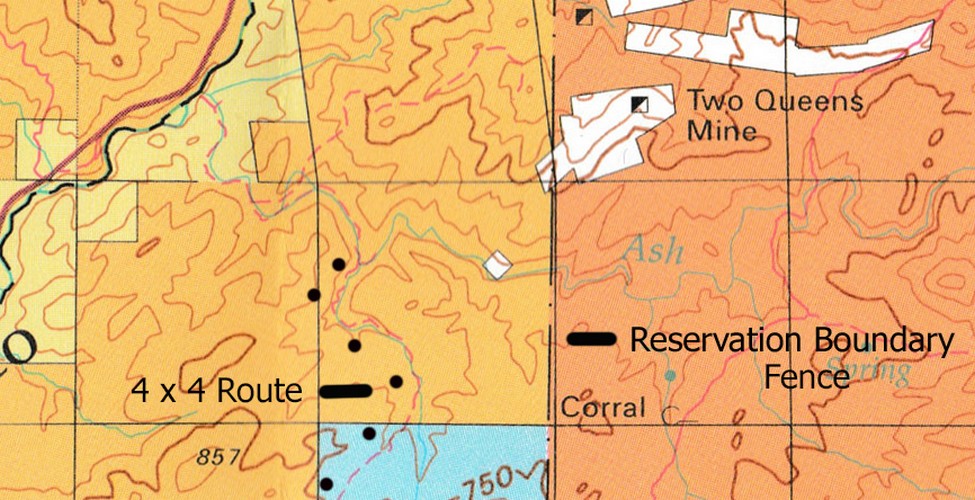 |
In this Google Earth View, the tree covered bend in Ash Creek was the location where the Two Queens Mine Camp was established. On the Mining Company's 1907 map above, the proposed Mill was going to be constructed here. On the BLM map, the camp site was at the small, isolated piece of private property that is identified a short distance southwest of the mining claims.
 |
On January 4th, 1907, the Arizona Republican published a full page article on the development of the Two Queens Mine. A description of the camp that was established to serve the miners was provided in this section of the article.
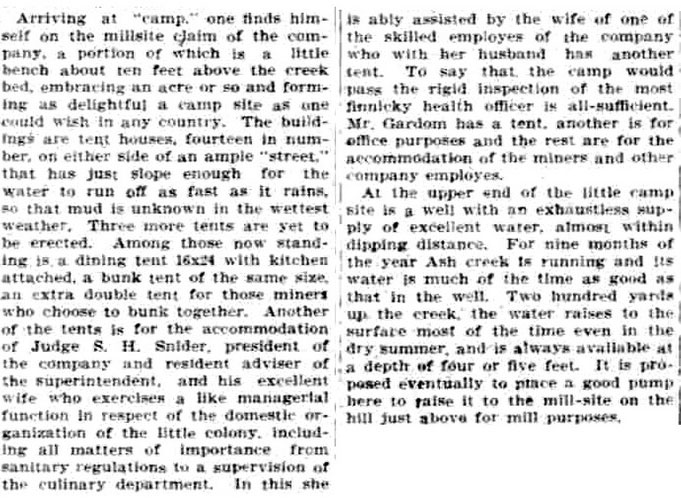 |
Today, the camp site is a nice place with lots of shade. Nothing seems to remain of the old camp, not even a can dump. There was no water at the surface two hundred yards above the camp as described in the article above . This critter is one of the current occupants.
Saddle Mountain is the dominant landmark in the area. This is the view to the east, on the trail that leads to the mine from the camp site. The peak was in the background of the photo of the miners used in the advertising document above.
.
In the 1970s, several of the old roads in the area were improved so that core drilling rigs could be brought in. The fence is the boundary between BLM land on the left and San Carlos Indian Reservation lands on the right. There is a gate where the road crosses on to the Two Queens mine property.
These heavy beams were most likely a part of the headframe that once stood over the shaft at the edge of the mine dump. That headframe is likely the one in the photo of the miners.
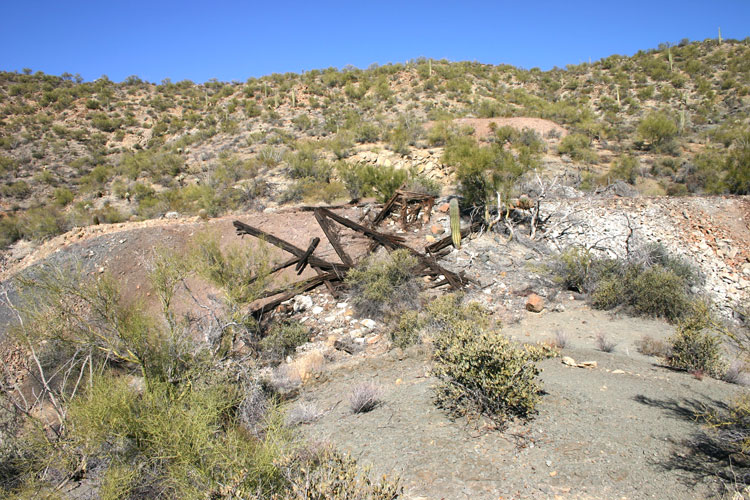 |
The underground geology must have been complex. There seems to be quite a few different rock types represented on the dump.
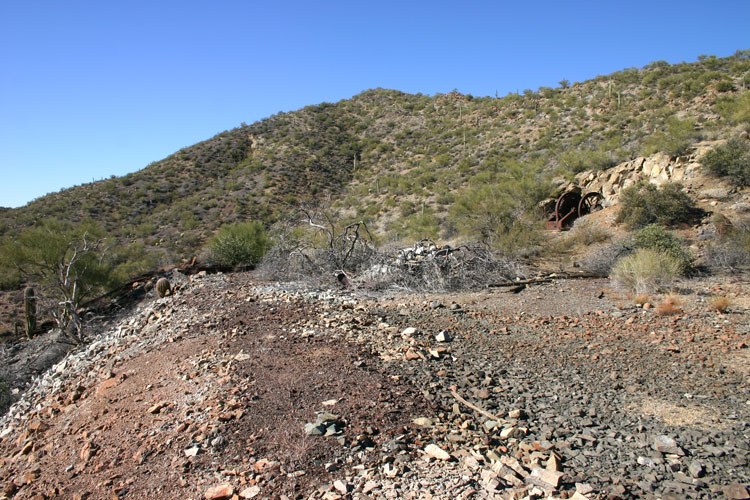 |
An air compressor and a mine hoist are the two interesting pieces of equipment that remain at the site. Early newspaper reports noted the arrival of the machinery in 1907. The equipment was most likely shipped by train to Winkelman where it would have been transferred to wagons that would have made their way northward along the Gila River to the mouth of Ash Creek. From there, the route would have been up the bed of Ash Creek to the camp site. The freight wagons would then have made their final push to the mine on the newly constructed road up from the camp.
The air compressor is the smaller machine to the left and the hoist is the larger machine to the right.
The manufacturers' plates have been removed from the pieces of equipment. After our trip, I posted this photo on the "Unidentified Engines" forum at www.smokstak.com to ask for help in identifying the machinery. There were immediate responses. It was suggested that the hoist was a Fairbanks Morse mine hoist driven by one of the company's gasoline fueled type "N" engines. A clue to the identification was the "tub" connected to the side of the engine. It was explained that this was a type of muffler used by the Fairbanks Morse Compay.
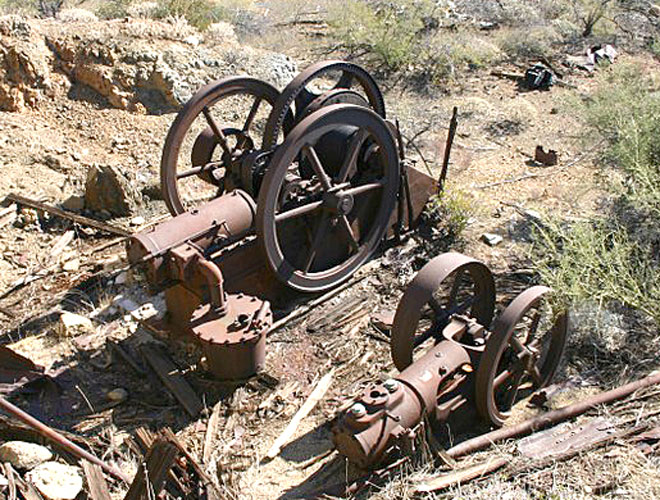 |
Apparently Fairbanks Morse produced this hoist in several different sizes. Each had a different horsepower rating. A table was posted on the forum that showed the characteristics of each of the hoists. Unfortunately, the table was posted after our trip, so I was not sure how helpful it would be. As it turned out, the table was quite useful.
The height listed for the 25hp hoist of 66" was familiar. I had actually measured the height of the flywheels and they were 66" tall. They were just a bit taller than my wife. The heights listed for the other machines were not close to that value.
 |
I had taken photos of the gears. The pinion gear could be seen in one of those. This was the transitional piece that connected the engine to the hoist. An inspection of that photo showed that there were more than 14 or 15 teeth on the gear and definitely less than 20. I think that the number 18 was a pretty solid guess. That was the size gear that was used on the 25 hp engne. I did not try to come up with a count for the number of teeth on the large gear. According to the table, there was not a lot of room for error in counting those.
I think that it would be a pretty good bet to make the claim that this machine was the 25hp version of the Fairbanks Morse Mine Hoist. As noted earlier, the early newspaper accounts had described that horsepower rating for the engine.
The piston bore on the engine was approximately 10 1/2"
The hoist cable ran to a shaft in the distance. What, if anything, is at the end of the cable is unknown. According to the table above, hoists of this size could hold up to 1200' of 5/8" cable and handle loads up to 3500 pounds. These machines are supposed to have weighed 12,000 pounds! The flywheel on the right was outfitted with a pulley to accommodate a flat belt.
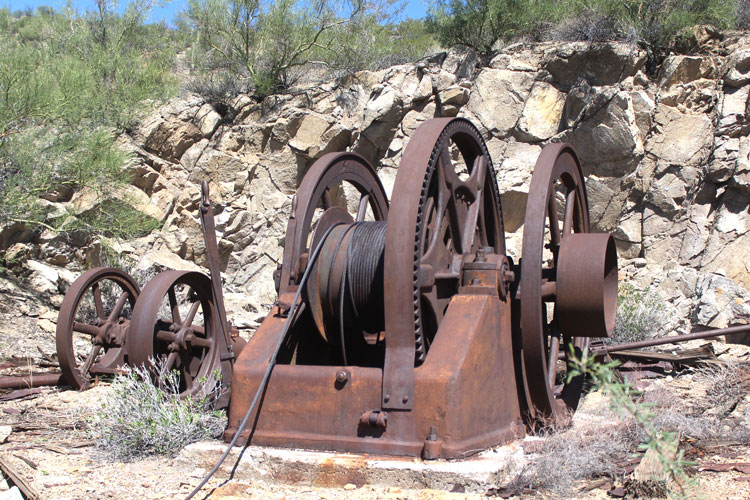 |
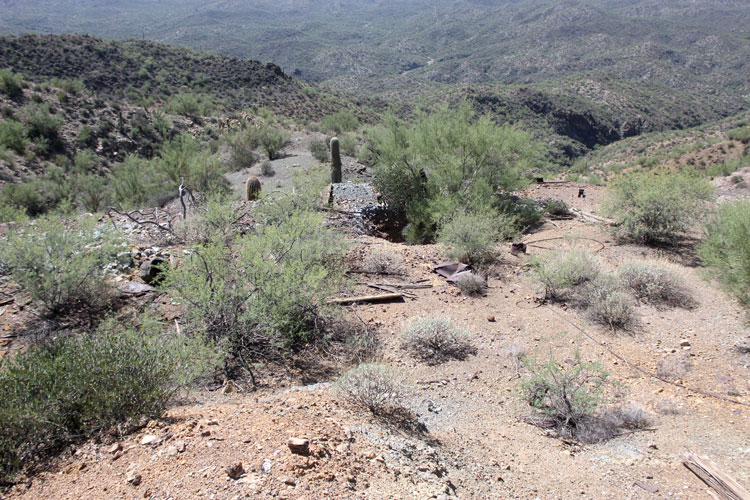 |
At the Smokstak site, there were photos posted of a nearly identical hoist. That hoist was known to have been powered by a 25 hp Fairbanks Morse engine. This photo, and others, with the hoist restored, were posted here.
 |
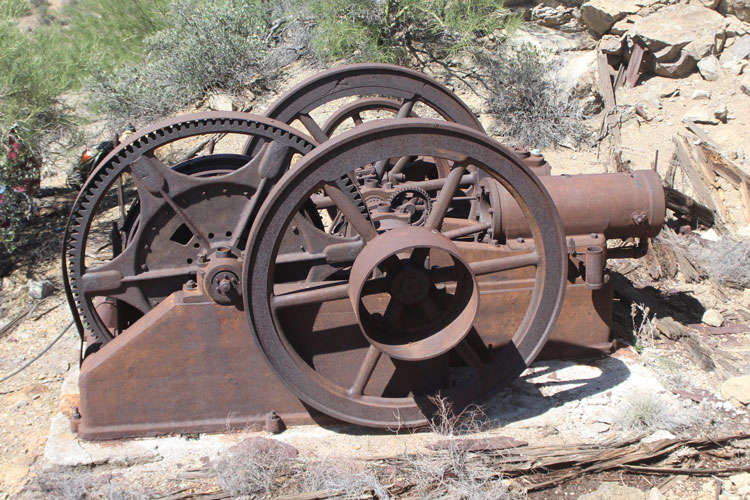 |
At this point in time, the manufacturer of the air compressor is unknown. Its identification is a project to be completed! The flywheel on the left is outfitted for the attachment of a flat belt.
 |
This shaft may have been used to direct power from the hoist engine to the air compressor. Two belts and two pulleys would have accoomplished that task.
Enough elevation was gained on the walk into the Two Queens Mine that it was possible to get a view of the tailings pile and the smelter stack at Hayden.
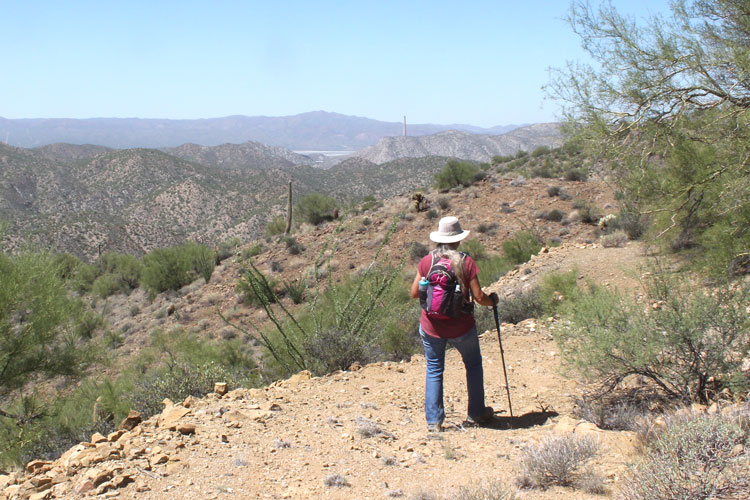 |
It was 100° when we returned to our truck. We each had a gallon of water in our packs and are able tolerate heat pretty well so the hike had not been real strenuous. Even so, we did not hesitate to get into the ice chest and get after the cold drinks that were there.
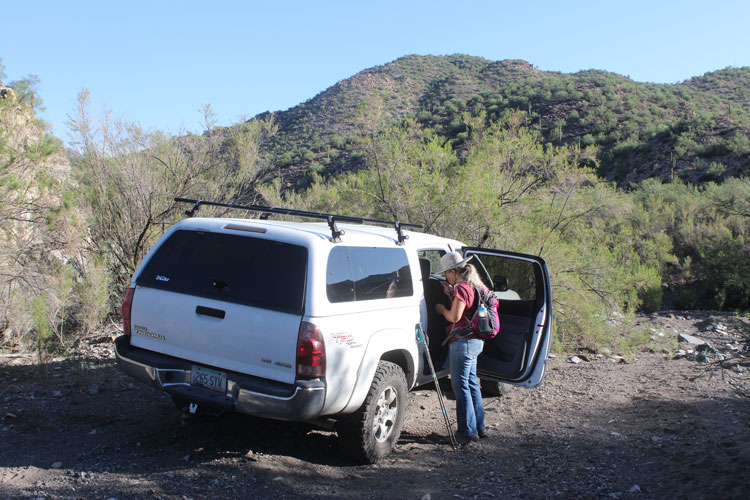 |
The ride out from Ash Creek was less stressful than the ride in. I am more comfortable going up the rough spots than trying to ease my way down them.....
 |